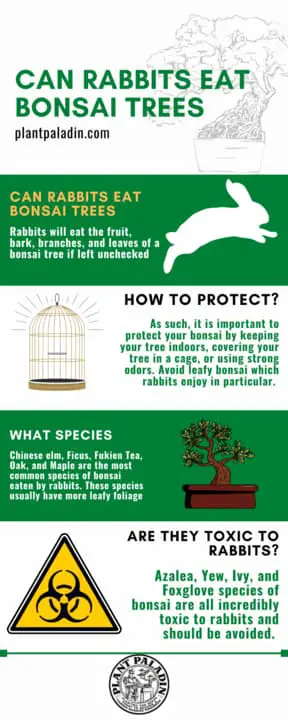This website is supported by its readers. If you click one of my links I may earn a commission. I am also a participant in the Amazon affiliates program and I will also earn a commission from qualified purchases.
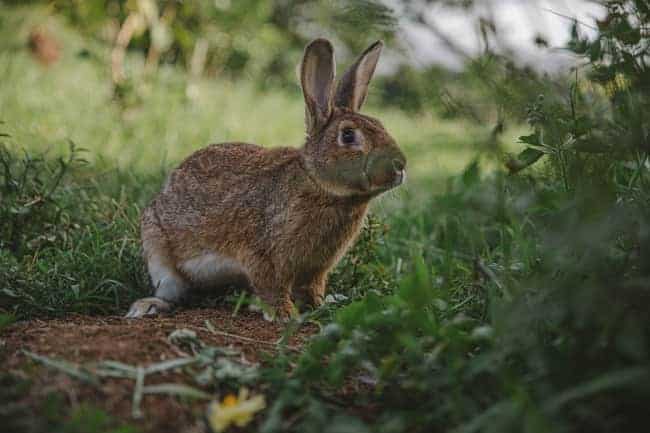
Recently one of my nephews bought a rabbit and decided to bring it over to my new house. As I now have a sizable bonsai collection in my garden, this got me thinking, can rabbits eat bonsai trees?
Rabbits will eat the fruit, bark, branches, and leaves of a bonsai tree if left unchecked. As such, it is important to protect your bonsai by keeping your tree indoors, covering your tree in a cage, or using strong odors. Avoid leafy bonsai which rabbits enjoy in particular.
So what bonsai species do rabbits like to eat in particular? And how can you prevent rabbits from eating your bonsai? Keep reading to find out more!
Just a quick heads up, over the past three years of running Plantpaladin, hundreds of people have asked for product recommendations. As such, You can find my favorite indoor bonsai tree here (link takes you to Bonsaiboy), my favorite outdoor bonsai tree (link takes you to Bonsaiboy), or have a look at all the products I recommend here.
Can rabbits eat bonsai trees?
Rabbits are one of the most popular pet species in the world, with an estimated 2% of households in the UK owning them and around 6 million rabbits being kept as pets in the USA.
With bonsai trees becoming more and more popular, It’s important to know if rabbits can eat bonsai trees.
As such, I got in touch with my local bonsai experts, spoke with a local vet, and even did a quick survey of 10 plant paladin readers who also own rabbits.
To summarise:
- Rabbits will eat and chew on bonsai trees if bonsai trees are left unprotected.
- They will use the bark and branches as a way of gnawing and training their teeth.
- Rabbits will also consume the leaves of the bonsai as food – This is because 75% of a rabbit’s diet is made of greens meaning your bonsai leaves will bear the brunt of any damage caused by rabbits.
- Elms, Ficus, and Jade are all species rabbits like to eat due to the number of leaves and their great ramification.
- Bonsai trees that bear fruit such as apple, orange, lime lemon, and cherry should be okay, as rabbits do not typically eat a lot of fruit and vegetables – Care should be taken however as the seeds in these fruit bonsai will be toxic to rabbits. Even Olive bonsai can be toxic with its leaves and bark in particular
- Some bonsai species such as Azaleas, Yew, Ivy, and Foxglove are toxic to rabbits.
- The bark on cedar and pine bonsai is also toxic to rabbits.
What bonsai trees do rabbits like to eat
Chinese elm, Ficus, Fukien Tea, Oak, and Maple are the most common species of bonsai eaten by rabbits. These species usually have more leafy foliage for rabbits to graze on than other varieties. Rabbits have also been known to eat succulents such as Jade due to their water content.
To help explain more I’ve put together a table below explaining why:
Bonsai Species | Why Rabbits Eat them |
Chinese Elm | Strong density of leaves - most common bonsai species available |
Ficus | Strong density of leaves - most common bonsai species available |
Fukien Tea | A large number of leaves that are usually spread out and easy to reach |
Maple | A high volume of leafy foliage, strong bark for training their teeth |
Oak | The high volume of leafy foliage, strong bark for training their teeth |
Jade | Leaves contain large amounts of water - can be refreshing for a rabbit. |
Olive | Common to find rabbits eating the dry leaves when there is a scarcity of other foods in warmer climates. |
Coniferous species of bonsai such as Pine (including Scots Pine), Junipers, and other varieties. Whilst they can be eaten by rabbits, they are often avoided due to the tip/needle-like nature of the leaves.
These leaves can get lodged in a rabbit’s throat causing rabbits to choke so extra care should be taken if you own these varieties.
How to stop rabbits from eating bonsai
So now we know the common types of bonsai trees that rabbits like to eat, what are some quick tips you can follow to prevent rabbits from chowing down on your prized possessions.
I found the best way to prevent this is to do the following:
- Grow larger bonsai
- Move your bonsai indoors
- Keep your bonsai in a cage
- Use scares
- Invest in strong odors
Let’s explore these in more detail:
Grow larger bonsai
If you have come to terms with the fact that parts of your bonsai will be gnawed and eaten by rabbits, and are content with that, then I think the best option for you will be to simply grow larger bonsai.
Larger bonsai trees such as four-hand, six-hand, or imperial-sized bonsai trees will have more leaves and branches.
This means that should a rabbit attack your tree, there will still be plants of leaves, branches, and bark left for your tree to hopefully recover from.
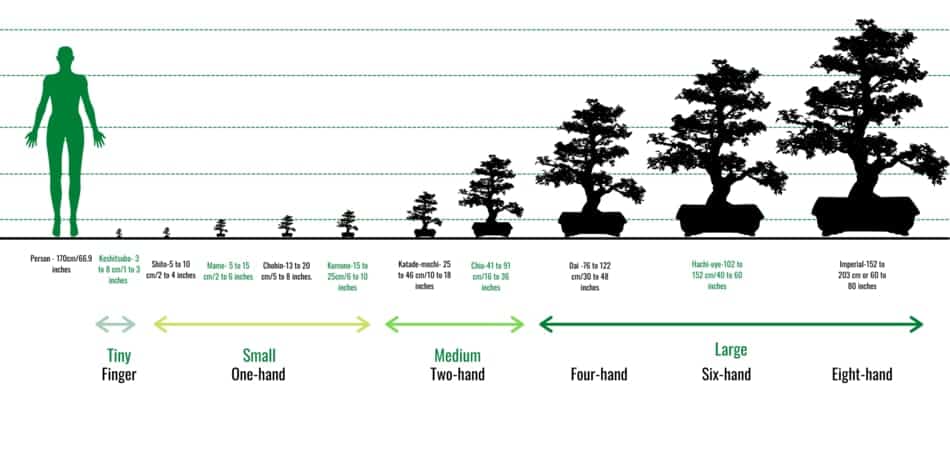
The only downside to this method however will be that it can take a lot of time for a bonsai tree to grow from scratch.
As such I would recommend looking at some of the more pragmatic solutions on this list.
Move your bonsai indoors
The vast majority of you reading this who own rabbits will keep them in a hutch or age or let them run around outdoors.
As such, one of the best things you can do for your bonsai trees is to keep them indoors.
The most popular varieties of bonsai such as Chinese elm or succulents like Jade can actively thrive indoors, so long as you ensure they get enough sunlight – either by placing them on a window or by giving artificial light.
This then will create a clear barrier and stop rabbits from eating your bonsai as they will not be in the same location.
Keep your bonsai in a cage
If you own bonsai that need to be outdoors, such as a Juniper bonsai, then moving your tree indoors won’t solve the problem.
A fantastic option then could be to create a bonsai cage.
Bonsai cage creates a protective mesh between your tree and any animal including rabbits that like to grace on them.
This can be undertaken in two ways.
- Planting skewers around the tree
- Creating a wire mesh cage
Plant skewers around the tree
The skewer method can be great at preventing rabbits from eating the bark or leaves of your tree – the most common areas that they like to eat.
To do this, plant metal skewers that are either store-bought or cut to size – these should be about 3 to 5cm for smaller trees but larger for larger bonsai.
Then plant these in the topsoil of your tree so they cover the perimeter of the bonsai.
This will prevent your rabbits from getting comfortable when grazing on your bonsai.
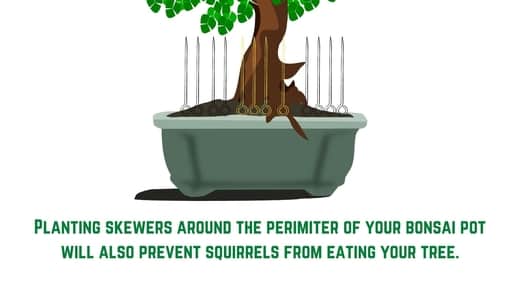
Creating a wire mesh cage
The wire mesh cage can also be used and is in my opinion a lot more effective.
To use this method use chicken wire to construct a cage that is about 20% larger than the size of your bonsai.
For my recommended chicken wire and the exact method to create a wire mesh – check out my post on bonsai trunk fusion here.
Then cover your tree from top to bottom – including the pot – to make sure that your bonsai has a fortress around it that rabbits cannot chew through.
Your bonsai will still get all the benefits of being outdoors such as direct sunlight and rainwater, without having to worry about it getting eaten by predators.
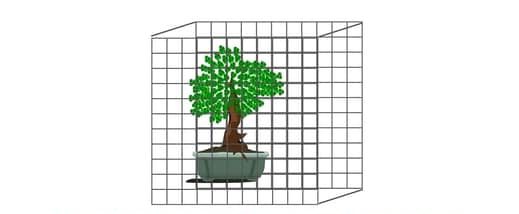
Use scares
Rabbits are notorious for scaring easily.
It’s one of the reasons why they do not like being picked up or held by people.
Rabbits are prey animals – meaning they are bottom of the food chain sadly for a lot of other animals.
Doing something as simple as playing the sound of a predator near your bonsai tree will prevent them from going near it.
This could be done through the sound of owls or foxes.
As rabbits can be trained fairly easily, after doing this for a few days your rabbit will avoid going near your bonsai tree as they will have a negative association.
An example of the sounds you can play can be found below:
https://www.youtube.com/watch?v=Cq2lnY4ay4o
Invest in strong odors
Another way to train rabbits to stay away from your bonsai is by having smells that are off-putting to rabbits near your bonsai.
Some smells in particular include predator musk or urine and blood.
Now I don’t know about you but I don’t keep any of those around the house!
Luckily, however, you can get the same effect with items like vinegar, ammonia, garlic, and red pepper.
You can simply spray or place these on top of the potting soil for your tree.
For the best method, I like to drape a dawn towel near my bonsai and spray it with vinegar or your spray of choice and leave it to hang.
Are bonsai trees poisonous to rabbits?
Azalea, Yew, Ivy, and Foxglove species of bonsai are all incredibly toxic to rabbits and should be avoided. The bark from Cedar, and Pine bonsai is also toxic to rabbits, The seeds of fruiting bonsai such as Plumb and Cherry bonsai are also toxic to rabbits.
Most bonsai species will have some form of toxicity for rabbits if they eat them – even if it is mild.
To read up more on this, I would recommend having a look at my post here.
Can rabbits eat bonsai trees? – Study
Finally, I undertook a quick survey of 10 plant paladin readers who also own a rabbit and asked them if a rabbit has eaten their bonsai tree in the past – here were the results:
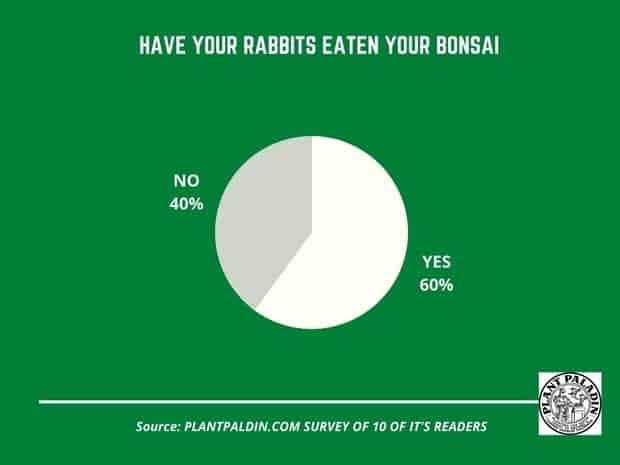
If you are struggling with other animals eating your bonsai trees then I would also recommend having a look at some of the following posts too:
My top picks for the gear you will need!
So like I mentioned earlier, over the past three years of running PlantPaladin, hundreds of people have asked me for my recommendations on the best bonsai gear on the market.
Having spent thousands of dollars on bonsai items these past few years and tested at least 100 bonsai-specific products, I’ve listed my favorite products below – All of which I highly recommend and think you can get great value.
They can purchase directly by clicking the link to take them to Amazon.
Bonsai Tool Set: One of the significant challenges I’ve had is finding a toolset that was not only durable but didn’t break the bank. SOLIGT has recently developed a fantastic bonsai tool set that covers all the tools you need to trim, prune, and repot your trees. – You can grab it here.
Complete Bonsai Set: Many of you will want to grow your bonsai trees entirely from scratch, but finding the varicose seeds, pots, and other items in one place can be challenging. Leaves and Sole then have created a complete bonsai set that I’ve personally used that ticks all the boxes. You can grab it here.
Bonsai wire: The number of times I’ve run out of wire for my bonsai or purchased cheap bonsai wire that doesn’t do the job is embarrassing for me to admit. After a lot of trial and error, I found that using Hotop’s aluminum bonsai wire is one of the best options on the market. This can easily be used for both indoor and outdoor bonsai. You can grab it here.
This post was written by Fehed Nicass who has been passionate about bonsai for over 3 years.

